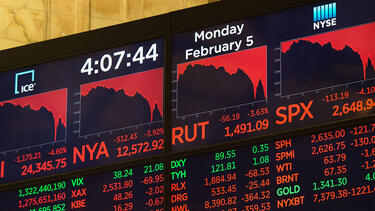How Do Investors Respond to Uncertainty?
Conventional wisdom says that uncertainty is bad for markets. But when Yale SOM’s Stefano Giglio and his co-authors examined data on a wide range of options prices, they found that investors are willing to pay a premium to protect themselves against actual market volatility but not mere uncertainty. Their study hints that rising uncertainty may be a sign of good things to come.

A display at the New York Stock Exchange on February 5, 2018, when the Dow Jones Industrial Average fell by more than 1,000 points. Photo: Bryan R. Smith/AFP/Getty Images.
By Jyoti Madhusoodanan
Uncertainty in the economy—triggered, say, by a change in government, a diplomatic conflict, or a turn of the business cycle—is usually considered bad news for people who want to invest their money. But a new analysis from researchers at the Yale School of Management and Northwestern University looked at an unprecedentedly wide range of markets and found that investors are more concerned about actual volatility in prices than periods of high uncertainty. Indeed, their analysis suggests that investors historically have viewed periods of high uncertainty as being good news.
“There’s good reason to believe that just uncertainty by itself is bad,” says Yale SOM professor of finance Stefano Giglio, who led the study. The theory goes that a jump in uncertainty makes firms and individuals less likely to invest, driving down growth. “But we also know that when there’s high volatility there’s also high opportunity. So it wasn’t entirely clear: Are investors truly worried about market uncertainty?”
To answer that question, Giglio and his colleagues examined the prices of options, which are contracts that give investors the ability to buy or sell assets at a pre-specified price at some point in the future. They drew these data from the CME group, which includes information from the Chicago Mercantile Exchange, the Kansas City and Chicago Boards of Trade, and the New York Mercantile and Commodity Exchanges. This allowed them to examine options on financial assets, such as the S&P 500 and Treasury bonds, as well as commodities, including oil and metals. As a result, the study has implications for both financial markets and the broader real economy.
Read the study: “How do investors perceive the risks from macroeconomic and financial uncertainty? Evidence from 19 option markets”
Giglio and his colleagues parsed the data in two ways to distinguish between an actual economic fluctuation versus the mere risk of change. Giglio compares it to purchasing insurance that protects against wildfires: Consider ten cities that all have a 1% risk of fire. One could purchase insurance that protects against an inferno, so the insured person is paid in case of a fire. Or an individual might opt for insurance that protects against an increased risk of fire—so if the risk spikes from 1% to 50%, they receive payment from the insurance company. While the former reflects worry about a fire itself, the latter option—purchasing insurance against an increased incendiary risk—stems from a fear of uncertainty.
The researchers assembled portfolios of options that revealed how investors have historically responded to actual drops in prices of the underlying commodities, termed the realized volatility (RV) portfolio, on the one hand, versus the risk of a change rather than an actual drop, termed the implied volatility (IV) portfolio—or uncertainty, in common parlance. “By buying and selling certain kinds of options, you can create a portfolio that pays you when uncertainty is high,” Giglio says.
Then the team used these portfolios to calculate how much of a premium investors were willing to pay for each kind of options. Across both the financial and non-financial markets, investors paid heavy premiums to insure against the risk of an actual loss. But investors didn’t choose to pay to insure themselves against implied volatility—in other words, the risk of uncertainty didn’t scare them.
In fact, investors seemed to do the opposite in the nonfinancial markets. “We found they were insuring against periods of low volatility, which is completely at odds with theories about how investors should handle uncertainty,” Giglio says. “This is the first time research has shown that investors are clearly not willing to pay to insure against high uncertainty in the markets.”
One implication of this finding is that periods of high uncertainty are not necessarily “bad” economic states, but possibly times of innovation, creative destruction, competition, and ultimately, growth. In the future, it would be interesting to understand if there are various kinds of uncertainty and if these can influence investors’ decisions differently, Giglio adds.
The data also imply that perhaps policymakers need not always focus their efforts on stability in all areas. Since investors aren’t scared by uncertainty, it may be preferable to prioritize actions that prevent an economic downturn at the expense of stability. “Our results help policymakers figure out what needs to be stabilized versus what doesn’t,” Giglio says.